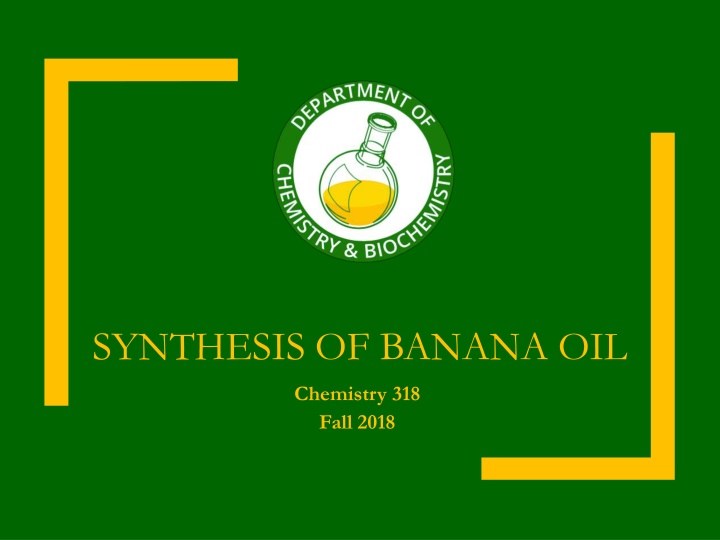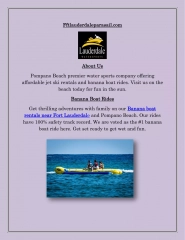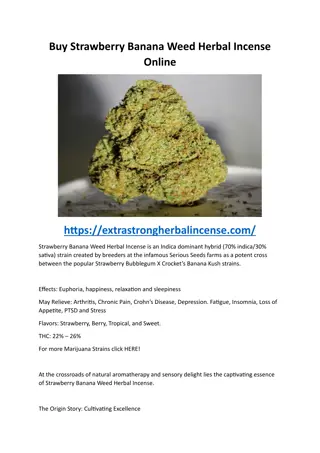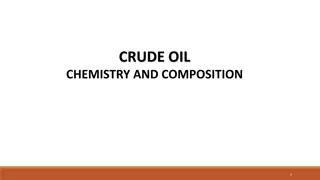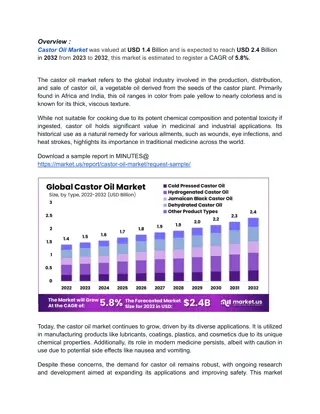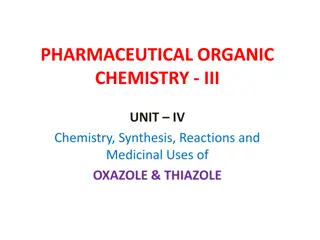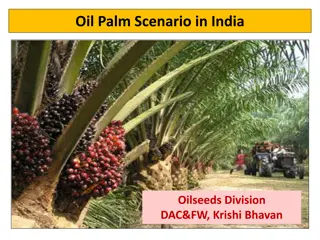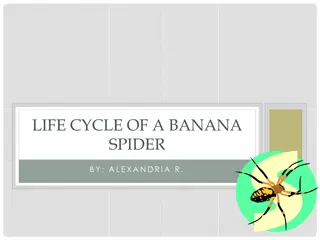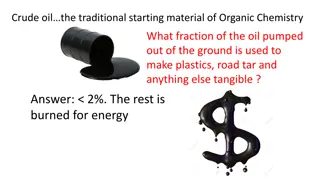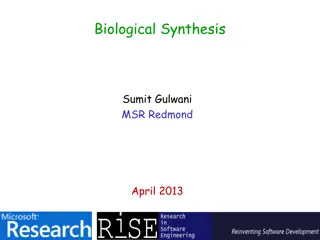Synthesis of Banana Oil in Chemistry Class
The synthesis of banana oil involves a reaction between carboxylic acid and alcohol catalyzed by H2SO4 to produce isoamyl acetate. The mechanism includes nucleophilic acyl substitution with two main reaction steps - addition and elimination. The process shifts the equilibrium to favor product formation by using acetic acid in excess. The H2SO4 catalyst protonates both the alcohol and the acetic acid, facilitating the reaction. Overall, the synthesis of isoamyl acetate undergoes several steps to form the final product.
Download Presentation

Please find below an Image/Link to download the presentation.
The content on the website is provided AS IS for your information and personal use only. It may not be sold, licensed, or shared on other websites without obtaining consent from the author.If you encounter any issues during the download, it is possible that the publisher has removed the file from their server.
You are allowed to download the files provided on this website for personal or commercial use, subject to the condition that they are used lawfully. All files are the property of their respective owners.
The content on the website is provided AS IS for your information and personal use only. It may not be sold, licensed, or shared on other websites without obtaining consent from the author.
E N D
Presentation Transcript
SYNTHESIS OF BANANA OIL Chemistry 318 Fall 2018
Schedule of day PPE check at the door Pre-lab check at the door Quiz Recitation Synthesis of Banana Oil Safety Put bags away Goggles Gloves Lab Coat LAB!
Due Dates Today At beginning of lab - Aldehydes and Ketones Report For instructions, see Notebook & Report Formats for Unknown ID in Bb End of lab yellow Notebook pages (Synthesis of banana oil). Next Week Synthesis of Banana Oil Report For instructions, see Notebook & Report Formats for Synthesis reports in Bb.
Synthesis of Isoamyl Acetate (Banana Oil) Carboxylic acid + alcohol ester + H2O O CH3 O CH3 H2SO4 CH3C O H CH2CH2O H CH3CH CH3C O CH2CH2CHCH3 H OH acetic acid 3-methyl-1-butanol (isoamyl alcohol isopentyl alcohol) isopentyl acetate The reaction is acid-catalyzed Much too slow in the absence of H+ The reaction is an equilibrium reaction Equilibrium must be shifted to favor product Acetic acid used in excess
Synthesis of Isoamyl Acetate Mechanism: nucleophilic acyl substitution 2 main reaction steps: 1) addition, and 2) elimination overall substitution
Synthesis of Isoamyl Acetate CH3 CH3 H2SO4 H H CH3 CH CH2 CH2O CH3 CH CH2 CH2O H The H2SO4catalyst can protonate both the alcohol and the acetic acid. The alcohol OH is a stronger base than the >C=O of the carboxyl group
Synthesis of Isoamyl Acetate The H+is transferred to the oxygen of the carboxyl group, which makes the C=O more electrophilic. CH3 CH2 CH2O H H H CH3 CH O The C=O is now more electrophilic O H CH3 C O CH3 O H CH3 C The OH acts as a nucleophile and attacks the C=O H CH3 CH CH2 CH2O After the alcohol attacks the protonated carboxyl in the addition step, a new bond is formed in the tetrahedral intermediate
Synthesis of Isoamyl Acetate The tetrahedral intermediate has protons removed and added by other bases and acids in solution H H The proton shifts are intermolecular, not intramolecular O O O H O H CH3 C CH3 C CH3 CH3 H O O CH3 CH CH2 CH2 CH3 CH CH2 CH2 H The tetrahedral intermediate undergoes proton shifts. The two OH groups are equivalent -- either can be protonated. The protons shown in color are equivalent, but they are being "formally" kept account of here.
Synthesis of Isoamyl Acetate The oxonium ion OH2+is a good leaving group. The carbon-oxygen bond breaks H H O O O H CH3 C CH3 C CH3 CH3 H H O O CH3 CH CH2 CH2 CH3 CH CH2 CH2 O CH3 C CH3 H2O leaves, forming a cation that is stabilized by resonance O CH3 CH CH2 CH2 The cation that results is stabilized by resonance with both oxygens (only one resonance contributor shown)
Synthesis of Isoamyl Acetate The proton is removed by bases that are present, such as the alcohol (ROH) or the carboxylic acid (RCO2H) or water (H2O). H O O CH3 C CH3 C CH3 CH3 H+ O O CH3 CH CH2 CH2 CH3 CH CH2 CH2 The product is the ester and the byproduct is water The acid catalyst is regenerated and the cycle continues
Experiment Notes Reflux apparatus Reflux apparatus Drying tube containing cotton Liquid boils in round bottom flask Vapors ascend into the condenser The cold inside glass condenses the vapor to a liquid, which drips back into the flask Water out Water in Round bottom flask Al block or sand bath Hot plate 6 6 5 5 7 7 4 4 8 8 3 3 9 9 2 2 11 10 10 1 1 1
Experiment Notes Have reflux apparatus ready, but add liquids to flask away from heat source Weigh vial + isopentyl alcohol Pour alcohol into RBF using a funnel Re-weigh empty vial Measure volume of acetic acid using grad. cylinder and add to RBF Add 1 ml H2SO4and SWIRL the flask to mix Round bottom flask
Experiment Notes Assemble the reflux apparatus let me check it before you move on! Drying tube containing cotton Water out Remember drying tube and boiling stones! Water in Heat to boiling for 60 minutes. Then, cool to room temperature. Round bottom flask Al block or sand bath Hot plate 6 6 5 5 7 7 4 4 8 8 3 3 9 9 2 2 11 10 10 1 1 1
Separation of Product O O CH3 CH3 C O H CH3 C O CH2CH2CHCH3 CH3 H OH H2SO4 CH3 CH CH2 CH2 O H Extract organic layer first with water. Then extract with 5% NaHCO3(aq.). CAUTION: gas build-up in funnel vent after every shake. What does sodium bicarbonate extract? Finally, extract organic layer with saturated NaCl (aq.).
Separation of Product Always keep the upper organic layer in the separatory funnel. Drain the lower aq. layers into the beaker (combined aqueous waste). After the last extraction, pour the organic layer through the top of the funnel into a small Erlenmeyer flask.
Separation of Product Add Na2SO4as drying agent (anhydrous). After absorbing H2O from the organic layer, it becomes the hydrated salt Na2SO4 nH2O After ester is dried, transfer (decant) liquid to a small vial. Take refractive index and IR.
